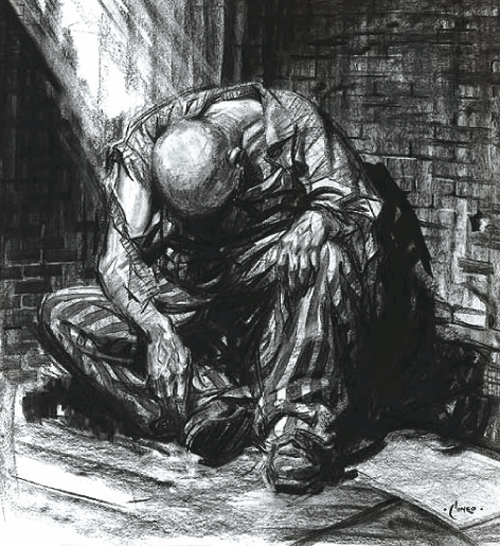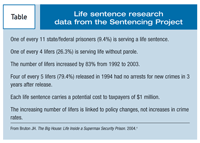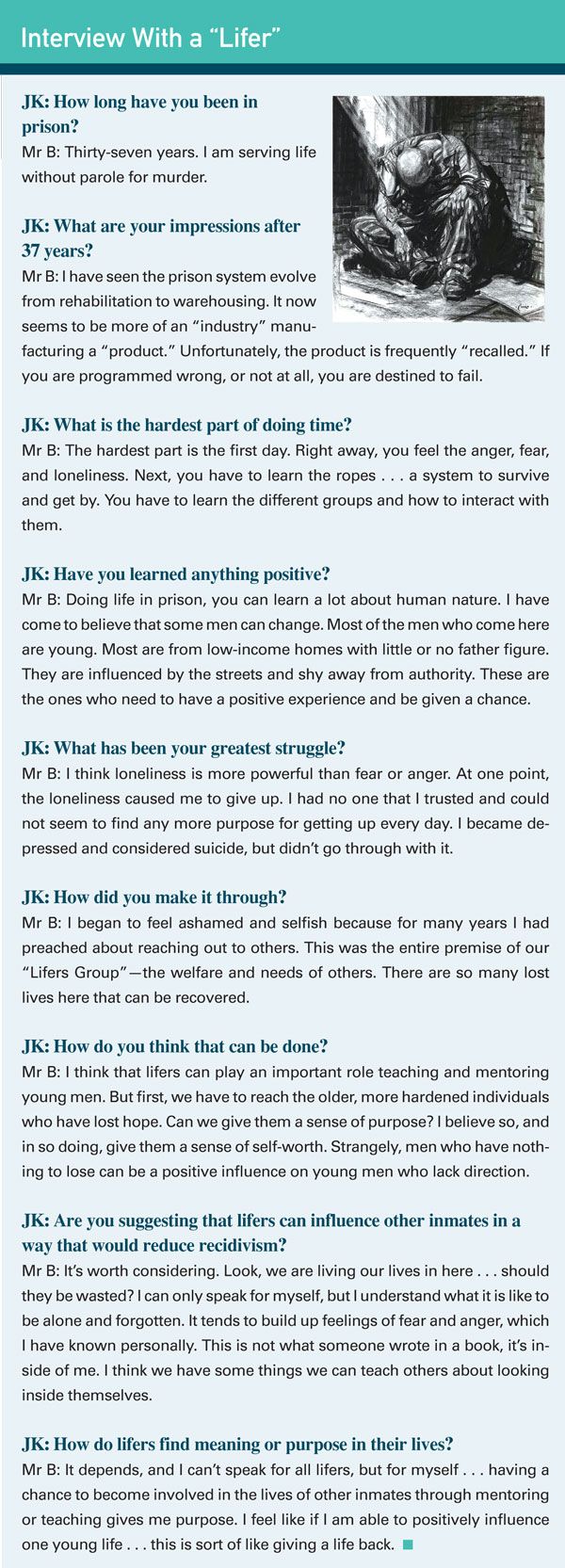Publication
Article
Psychiatric Times
Discussing the Meaning of Life With a “Lifer”
Author(s):
The process of adapting to prison life, or “prisonization,” exerts a dehumanizing effect that may result in feelings of hopelessness and alienation.

The process of adapting to prison life, or “prisonization,” exerts a dehumanizing effect that may result in feelings of hopelessness and alienation.1 The psychological effects of prison are believed to vary according to the individual. However, during imposed institutionalization, the inmate is vulnerable to the development of harmful attitudes-such as a negative self-concept, devaluation of life, and other generally destructive cognitions. It might be hypothesized that inmates serving life sentences (“lifers”) and who spend the longest time in prison would undergo the greatest degree of prisonization. Whether the life sentence results in an attitude characterized by nihilism or adaptation is unknown; however, one could speculate that an individual’s pre-incarceration coping skills and overall constitution play a role.
Because the plight of the lifer is often unknown to free society, allow me to provide some factual highlights. Life sentences are actually rare among convicted felons. However, among the 8990 persons serving their sentences in US prisons in 2002 who were convicted of murder or non-negligent manslaughter, 24.1% were sentenced to life in prison.2 In one of the few reports of its kind, the Sentencing Project published findings on the imposition of life sentences in the United States.3 Some of the major findings of the report are listed in the Table.
Lifers and the Sentencing Project

What did the report have to say about lifers with mental illness? The high rate of mental illness in prison is even more pronounced among lifers. Approximately 1 in 4 lifers has mental illness. The report raises concerns about how the high rate of mental illness among lifers reflects on the criminal justice system’s handling of persons with serious mental illness. One implication is that inadequate criminal defense services may contribute to unreliable and/or unfair outcomes.
Lifers appear, at best, to be a forgotten group for whom many would question whether rehabilitation is an acceptable goal. Yet it is important to remember that lifers constitute a heterogeneous group in many respects, and some life sentences can be the result of what is arguably an arbitrary decision. Indeed, there is no scientifically determined sentence length for a given offender and/or his or her circumstances. For those who have been given a life sentence, the accuracy and fairness of the criminal proceedings would seem to carry high stakes that are only surpassed by the death penalty.
He who has a why to live for can bear almost any how.
-Nietzsche, Twilight of the Idols
Persons serving true life sentences (life without possibility of parole) exist in a unique set of circumstances. Lifers must somehow adapt to the reality that there will be no future release date to sustain hope or a sense of purpose. One might speculate that because they have been subject to an extreme form of permanent social exclusion, lifers would have an increased degree of hostility, mistrust, and nihilistic attitudes. However, as correctional staff can attest, this is not always the case. Lifers often have the regard of their fellow inmates and may be respected for having met the challenge of surviving in prison. Veteran correctional authorities note that some lifers “seem to mature into acceptance of their situation. Many take on a leadership role, setting a positive example … for other inmates.”4

To be sure, lifers are also in a position to use prestige and a “nothing to lose” attitude to control and/or manipulate other inmates in less than helpful ways. Some true lifers with nothing to lose may act as so-called shot-callers of inmate gangs. The existence of organized crime in corrections is an unsettled and unsettling dilemma. In fact, US attorneys have had to prosecute leaders and members of highly sophisticated organized crime syndicates that operate out of the nation’s prisons. Aryan Brotherhood gang members have been convicted of running an extensive criminal enterprise from behind bars that involved murder, narcotics trafficking, and conspiracy in an effort to rule the nation’s prisons.5 In some worst-case scenarios, incarcerated gang leaders have ordered the murders of persons living in the community.
One study of those offending during incarceration found that 40% of inmates were “chronic or extreme career offenders even while incarcerated.”6 A small cadre of inmates accounted for 100% of the murders and 75% of the rapes in prison. These individuals appear to be fundamentally different from the rest of the prison population. Sure, there may be some overlap, but in general they are different-different from inmates with severe mental illness and different from non–mentally ill inmates who want to rehabilitate themselves.
The average layperson may be surprised that there are many lifers who strive to develop and maintain a pro-social, positive disposition. From a research standpoint, little is known about the psychological structure or psychiatric morbidity of lifers. Even less is known about effective treatment or programming approaches to lifers who struggle emotionally and who are otherwise unsuccessful in finding purpose to their “new life” in prison.
Why one lifer chooses a more positive path and another a more negative one is interesting to consider. My primary interest in lifers has stemmed from personal observations that life meaning and/or purpose in life appears to influence inmates’ coping styles and, in some cases, their risk of suicide. This interest has led me to the writings of Viktor Frankl, the first psychiatrist to emphasize the importance of studying meaning in life within a psychological context.7 Frankl’s experience as a Nazi concentration camp prisoner led him to conclude that a primary motivation for humans is a “will to meaning,” or a drive to find meaning and purpose in life. A failure to find meaning and purpose may result in feelings of hopelessness, suicidality, and other self-defeating actions.8
Inmates and the meaning of life
Based on the work of Frankl, the Purpose-in-Life (PIL) test was constructed to assess or quantify the construct of meaning in life.9 Surprisingly, there is little research on this subject as it relates to prison inmates. What research does exist was done primarily in the 1970s, and much about the correctional landscape has changed since. A 1973 study found that recidivists scored significantly lower on the PIL test than did first-sentence prisoners who, in turn, scored significantly lower than nonprisoners.10 In a 1977 study, inmates who were not serving life sentences scored significantly lower than nonprisoners on tests of meaning and purpose in life.11
Subsequent research has found an association between the development of substance abuse problems and a lack of purpose or meaning in life.12 One might speculate that the current abandonment of rehabilitative programming in corrections has only served to further reinforce the inmate’s diminished sense of self-worth and personal value.
Ultimately, feelings of diminished personal worth lead to a questioning of purpose. I have observed that once an inmate reaches some individualized level of nihilism, he demonstrates a greatly reduced ability to participate in and benefit from rehabilitative and treatment efforts (ie, no meaning = no purpose or reason to change). In addition, when an inmate has strong nihilistic beliefs, there is often little motivation to self-regulate behavior.
For the mind is its own place, and can make a hell of heaven, or a heaven of hell.
-Milton, Paradise Lost
These empirical observations of the adverse effects of nihilistic beliefs in inmates are consistent with research findings in nonincarcerated populations. For example, social rejection has been found to increase feelings of meaninglessness and to decrease self-awareness and the ability to self-regulate behavior,13,14 which ultimately leads to suicide and/or self-destructive behaviors.15 The “escape theory” denotes the individual’s motivation to escape from aversive self-awareness. The “escape” theory may have relevance to the psychology of inmates, particularly where the inescapable structure and discipline of a prison reduces their ability to use earlier maladaptive coping mechanisms to avoid aversive affect and self-awareness.
During my work in prison, I was approached by a lifer who wished to share his views and opinions. Mr B asked if I could assist him in getting his message across. I found this particularly interesting because his views reflected those of a true insider’s on the struggles and mindset of a lifer. Mr B’s opinions and answers to some of my questions appear in the Box at right.
Mr B mentions several issues that are consistent with Frankl’s views on successfully finding meaning/purpose. First, the “will to meaning” is a highly personal and individual endeavor. Second, achieving happiness through one’s life purpose often involves an outward focus-ie, it is “other-directed.” Admittedly, prison life appears to do little to encourage outward focus, especially in terms of healthy social and societal alliance building. Yet it is precisely through such other-directed engagement that the stagnating bonds of self-absorption can be loosened, and toxic feelings of societal “persecution” can be overcome. There would appear to be little risk involved in emphasizing such programs under the careful guidance of mental health professionals. In contrast, ignoring the opportunity to emphasize life meaning and other-directed interests may simply foster some inmates’ tendency to go into a “behavioral deep freeze” where misbehavior is reduced during the prison term, only to reemerge in society after release.7
References:
References1. Stinchcomb J. Corrections: Past, Present and Future. East Peoria, IL: American Correctional Association. Versa Press; 2005.
2. Durose MR, Langan PA. Felony Sentences in State Courts, 2002. Washington, DC: US Dept of Justice, Bureau of Justice Statistics; December 2004. NCJ 206916.
3. Mauer M, King RS, Young MC; The Sentencing Project. The Meaning of “Life”: Long Prison Sentences in Context. May 2004:1-35. http://www.sentencingproject.org/Admin/Documents/publications/inc_meaningoflife.pdf. Accessed August 17, 2009.
4. Bruton JH. The Big House: Life Inside a Supermax Security Prison. Stillwater, MN: Voyageur Press; 2004:157.
5. Richards T. Aryan Brotherhood leaders are convicted in murders. New York Times. July 29, 2006.
6. DeLisi M. Criminal careers behind bars. Behav Sci Law. 2003;21:653-669.
7. Frankl V. Man’s Search for Meaning. Boston: Beacon Press; 1959.
8. Edwards MJ, Holden RR. Coping, meaning in life, and suicidal manifestations: examining gender differences. J Clin Psychol. 2001;57:1517-1534.
9. Crumbaugh J, Maholick L. Manual for Instructions for the Purpose-in-Life Test. Munster, IN: Psychometric Affiliates; 1969.
10. Black W, Gregson R. Time perspective, purpose in life, extraversion and neuroticism in New Zealand prisoners. Br J Soc Clin Psychol. 1973;12:50-60.
11. Reker GT. The Purpose-in-Life test in an inmate population: an empirical investigation. J Clin Psychol. 1977;33:688-693.
12. Waisberg JL, Porter JE. Purpose in life and outcome of treatment for alcohol dependence. Br J Clin Psychol. 1994;33(pt 1):49-63.
13. Twenge JM, Catanese KR, Baumeister RF. Social exclusion and the deconstructed state: time perception, meaninglessness, lethargy, lack of emotion, and self-awareness. J Pers Soc Psychol. 2003;85:409-423.
14. Baumeister RF, DeWall CN, Ciarocco NJ, Twenge JM. Social exclusion impairs self-regulation. J Pers Soc Psychol. 2005;88:589-604.
15. Baumeister RF. Suicide as escape from self. Psychol Rev. 1990;97: 90-113.






